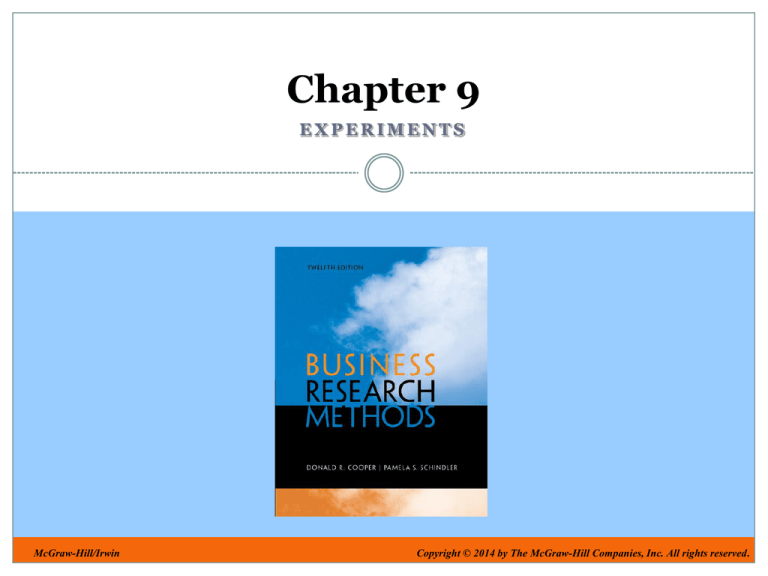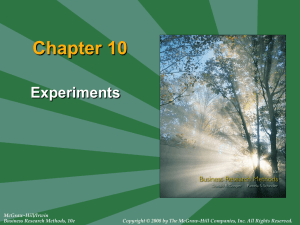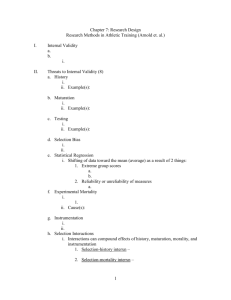
Chapter 9
EXPERIMENTS
McGraw-Hill/Irwin
Copyright © 2014 by The McGraw-Hill Companies, Inc. All rights reserved.
Learning Objectives
Understand . . .
Uses for experimentation.
Advantages and disadvantages of the
experimental method.
Seven steps of a well-planned experiment.
Internal and external validity with experimental
research designs.
Three types of experimental designs and the
variations of each.
9-2
Pull Quote
“This is a time of [e-book app]
experimentation. I’d be really
disappointed if we weren’t seeing both
successes and failures. I do think that
everyone seems to be looking at these
differently.”
Barbara Marcus, consultant and adviser,
Open Road Integrated Media
9-3
Causal Evidence
Agreement between
IVs and DVs
Time order of occurrence
Extraneous variables
did not influence DVs
9-4
Causal Evidence?
9-5
Evaluation of Experiments
Advantages
Disadvantages
Ability to manipulate IV
Artificiality of labs
Use of control group
Non-representative
Control of extraneous
variables
Replication possible
Field experiments
possible
sample
Expense
Focus on present and
immediate future
Ethical limitations
9-6
Experimentation
in the Research
Process
9-7
Conducting an Experiment
Specify treatment variables
Specify treatment levels
Control environment
Choose experimental design
Select and assign participants
Pilot-test, revise, and test
Collect data
Analyze data
9-8
Experiment: Placement of Benefits
Module
9-9
Selecting and Assigning Participants
Random
assignment
Matching
9-10
Random Assignment
Equal and known
chance of being
assigned to any group
in the experiment
9-11
Quota
Matrix
Example
9-12
Measurement Options
Observation
Physiological
measures
Paper-andpencil tests
Options
Scaling
techniques
Selfadministered
instruments
9-13
Validity in Experimentation
Internal
External
9-14
Threats to Internal Validity
Maturation
Experimental
mortality
History
Threats
Statistical
regression
Testing
Instrumentation
Selection
9-15
Additional Threats to Internal Validity
Diffusion of treatment
Compensatory equalization
Compensatory rivalry
Resentful disadvantaged
Local history
9-16
Threats to External Validity
Reactivity of
testing on X
Interaction of
selection and X
Other
reactive factors
9-17
Experimental Research Designs
Pre-experiments
True experiments
Field experiments
9-18
After-Only Case Study
X
O
Pre-experiment
9-19
One Group Pretest-Posttest
O1
X
O2
Pre-experiment
9-20
Static Group Comparison
X
O1
O2
Pre-experiment
9-21
Pretest-Posttest
Control Group Design
R
R
O1
O3
X
O2
O4
True experiment
9-22
Posttest-Only with Control Group
R
R
X
O1
O2
True experiment
9-23
Nonequivalent Control Group Design
O1
O3
X
O2
O4
Field experiment
9-24
Separate Sample
Pretest-Posttest
R
R
O1
(X)
X
O2
Field experiment
9-25
Group Time Series Design
R
R
O1 O2 O3 X O4 O5 O6
O7 O8 O9
O10 O11 O12
Field experiment
9-26
Close-Up:
A Job Enrichment Quasi-Experiment
9-27
Key Terms
Blind
Experiment
Control group
Experimental
Controlled test
treatment
External validity
Field experiment
Hypothesis
Independent variable
Internal validity
market
Dependent variable
Double-blind
Environmental
control
9-28
Key Terms
Matching
Operationalized
Quota matrix
Random assignment
Replication
Test market
Electronic test
market
Simulated test
market
Standard test market
Virtual test market
Treatment levels
Web-enabled test
market
9-29
Chapter 9
ADDITIONAL DISCUSSION OPPORTUNITIES
McGraw-Hill/Irwin
Copyright © 2014 by The McGraw-Hill Companies, Inc. All rights reserved.
Research Thought Leaders
“There is no such thing as a failed
experiment, only experiments with
unexpected outcomes.”
Richard Buckminster Fuller,
engineer and architect
9-31
Research Thought Leaders
“We need to keep an open mind and approach
life as a series of experiments. We need to
observe the experiments happening around us
and create new ones. Instead of accepting the
world as we think it is, we need to keep testing it
to find out what it is and what works .”
Jerry Wind
Wharton School of Business,
University of Pennsylvania
9-32
PulsePoint: Research Revelation
45
The percent of smartphone users who
check their e-mail before they get
dressed.
9-33
Snapshot: Online Dating
9-34
Snapshot: Email Subject Line
9-35
Snapshot: Wendy’s Burger Test Market
Test market selection
Do you want average?
Diversity
Funky culture
Creativity
Corporate Culture
9-36
Snapshot: Power of Message on
Beverage Consumption
Signs on beverage coolers
Did you know a bottle of
soda or fruit juice . . .
Has about 250 calories
(treatment #1)
Has 10% of daily calories
(treatment #2)
Takes 50 minutes of running
to work off (treatment #3)
9-37
Snapshot: Refining Store Design
9-38
Snapshot: The Right Size of Flavor
9-39
Chapter 9
EXPERIMENTS
McGraw-Hill/Irwin
Copyright © 2014 by The McGraw-Hill Companies, Inc. All rights reserved.
Photo Attributions
Slide Source
5 Courtesy of CfMC Research Software
11 Ingram Publishing
16 Purestock/SuperStock
20 Schedivy Pictures Inc./Getty Images
36 Royalty-Free/Corbis
37 Copyright ©Foodcollection
39 Courtesy of TGI Fridays
9-41




